实验一感知及其应用
作业信息
一、实验目的
1.理解感知器算法原理,能实现感知器算法;
2.掌握机器学习算法的度量指标;
3.掌握最小二乘法进行参数估计基本原理;
4.针对特定应用场景及数据,能构建感知器模型并进行预测。
二、实验内容
1.安装Pycharm,注册学生版。
2.安装常见的机器学习库,如Scipy、Numpy、Pandas、Matplotlib,sklearn等。
3.编程实现感知器算法。
4.熟悉iris数据集,并能使用感知器算法对该数据集构建模型并应用。
三、实验报告要求
1.按实验内容撰写实验过程;
2.报告中涉及到的代码,每一行需要有详细的注释;
3.按自己的理解重新组织,禁止粘贴复制实验内容!
四、实验过程及结果
实验代码及注释
1.
import pandas as pd #导入模块 import numpy as np from sklearn.datasets import load_iris#引用sklearn.datasets模块的一部分 import matplotlib.pyplot as plt %matplotlib inline#将matplotilb#绘制的图像显示在页面里,而不是弹出一个窗口
2.
%# load data iris = load_iris() df = pd.DataFrame(iris.data, columns=iris.feature_names)//将列名设置为特征 df['label'] = iris.target//增加一列为类别标签
3.
df.columns = ['sepal length', 'sepal width', 'petal length', 'petal width', 'label']//将各个列重命名 df.label.value_counts()value_counts//确认数据出现的频率
4.
plt.scatter(df[:50]['sepal length'], df[:50]['sepal width'], label='0')//绘制散点图
plt.scatter(df[50:100]['sepal length'], df[50:100]['sepal width'], label='1')
plt.xlabel('sepal length')//给图加上图例
plt.ylabel('sepal width')
plt.legend()
5.
data = np.array(df.iloc[:100, [0, 1, -1]]))#按行索引,取出第0,1,-1列
6.
X, y = data[:,:-1], data[:,-1]//X为sepal length,sepal width y为标签
7.
y = np.array([1 if i == 1 else -1 for i in y])//将两个类别设重新设置为+1 —1
8.
%# 数据线性可分,二分类数据 %# 此处为一元一次线性方程 class Model: def init(self)://将参数w1,w2置为1 b置为0 学习率为0.1 self.w = np.ones(len(data[0])-1, dtype=np.float32) //data[0]为第一行的数据len(data[0]=3)这里取两个w权重参数 self.b = 0 self.l_rate = 0.1 %# self.data = data def sign(self, x, w, b): y = np.dot(x, w) + b return y %# 随机梯度下降法 def fit(self, X_train, y_train)://拟合训练数据求w和b is_wrong = False//判断是否误分类 while not is_wrong: wrong_count = 0 for d in range(len(X_train))://取出样例,不断的迭代 X = X_train[d] y = y_train[d] if y * self.sign(X, self.w, self.b) <= 0://根据错误的样本点不断的更新和迭代w和b的值(根据相乘结果是否为负来判断是否出错,本题将0也归为错误) self.w = self.w + self.l_ratenp.dot(y, X) self.b = self.b + self.l_ratey wrong_count += 1 if wrong_count == 0://直到误分类点为0 跳出循环 is_wrong = True return 'Perceptron Model!' def score(self): pass
9.
perceptron = Model() perceptron.fit(X, y)//感知机模型
10.
x_points = np.linspace(4, 7,10)#默认linspace函数可以生成元素为50的等间隔数列。而前两个参数分别是数列的开头与结尾。如果写入第三个参数,可以制定数列的元素个数。
y_ = -(perceptron.w[0]*x_points + perceptron.b)/perceptron.w[1]
plt.plot(x_points, y_)#绘制模型图像(数据、颜色、图例等信息)
plt.plot(data[:50, 0], data[:50, 1], 'bo', color='blue', label='0')
plt.plot(data[50:100, 0], data[50:100, 1], 'bo', color='orange', label='1')
plt.xlabel('sepal length')
plt.ylabel('sepal width')
plt.legend()
11.
from sklearn.linear_model import Perceptron//定义感知机(下面将使用感知机)
12.
clf = Perceptron(fit_intercept=False, max_iter=1000, shuffle=False) clf.fit(X, y)//使用训练数据拟合
13.
%# Weights assigned to the features. print(clf.coef_)//输出感知机模型参数
14.
%# 截距 Constants in decision function. print(clf.intercept_)//输出感知机模型参数
15.
x_ponits = np.arange(4, 8)#确定x轴和y轴的值
y_ = -(clf.coef_[0][0]*x_ponits + clf.intercept_)/clf.coef_[0][1]
plt.plot(x_ponits, y_)#确定拟合的图像的具体信息(数据点,线,大小,粗细颜色等内容)
plt.plot(data[:50, 0], data[:50, 1], 'bo', color='blue', label='0')
plt.plot(data[50:100, 0], data[50:100, 1], 'bo', color='orange', label='1')
plt.xlabel('sepal length')
plt.ylabel('sepal width')
plt.legend()
实验结果截图
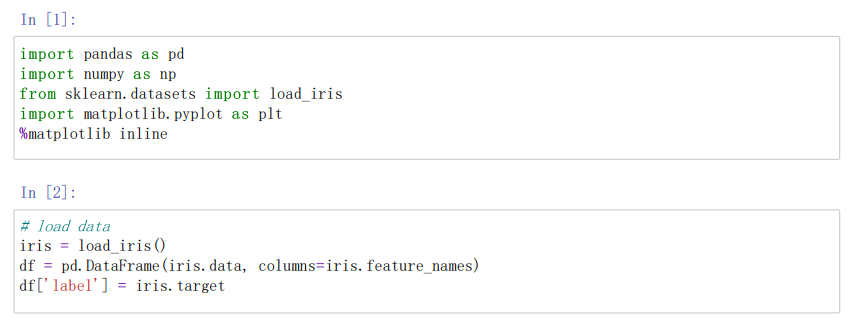
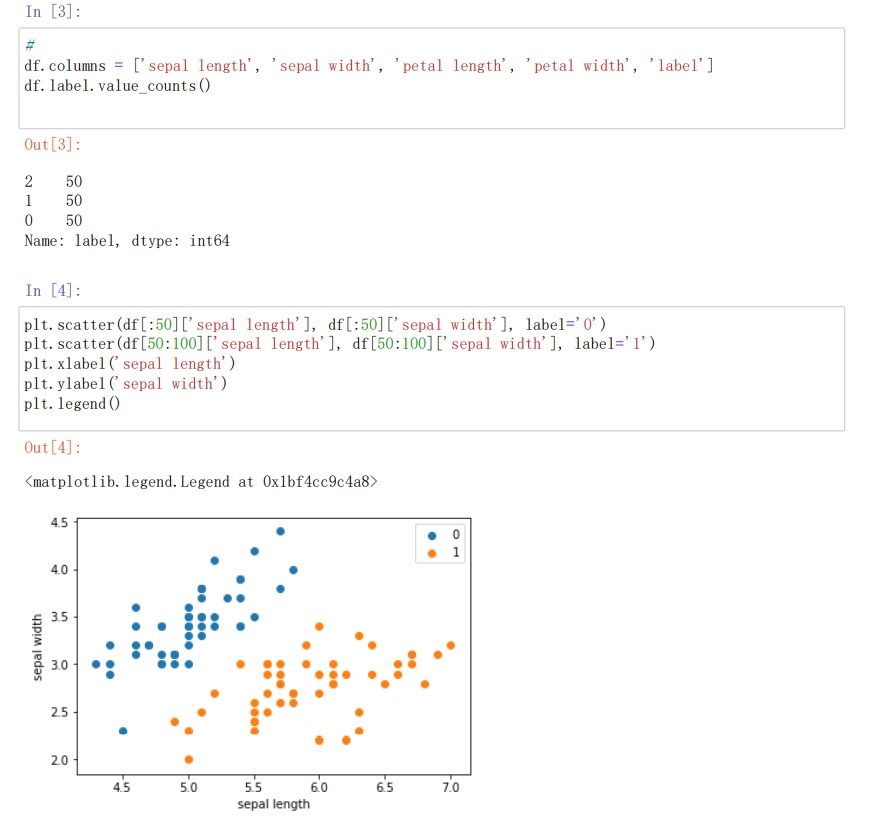
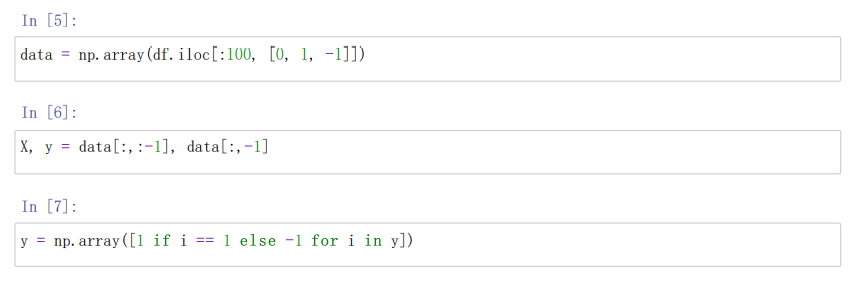
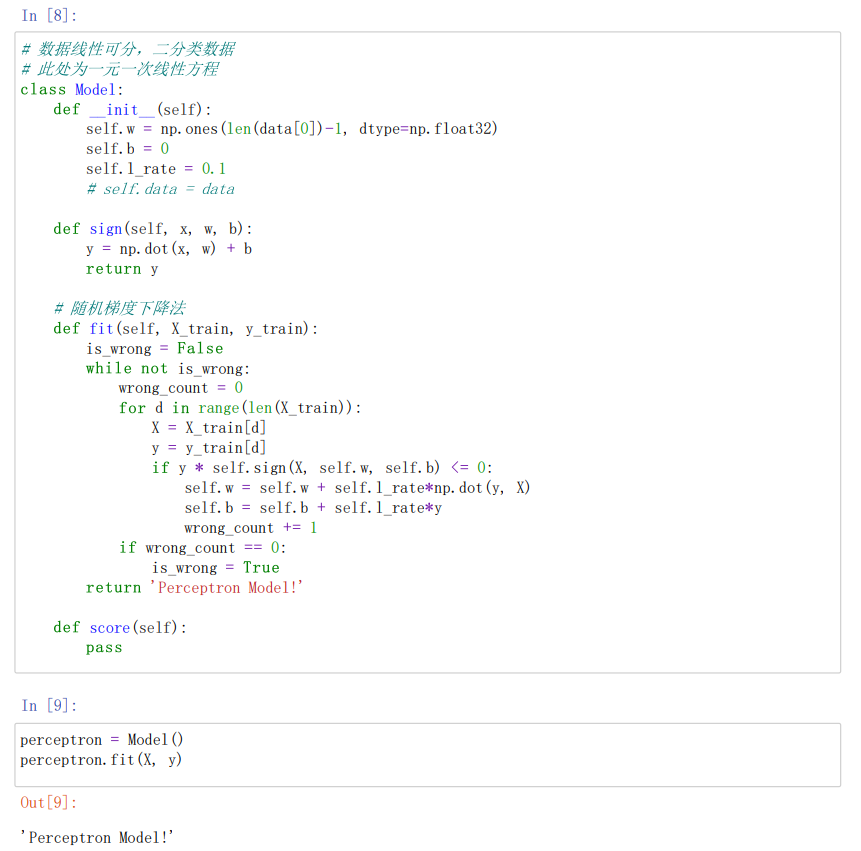
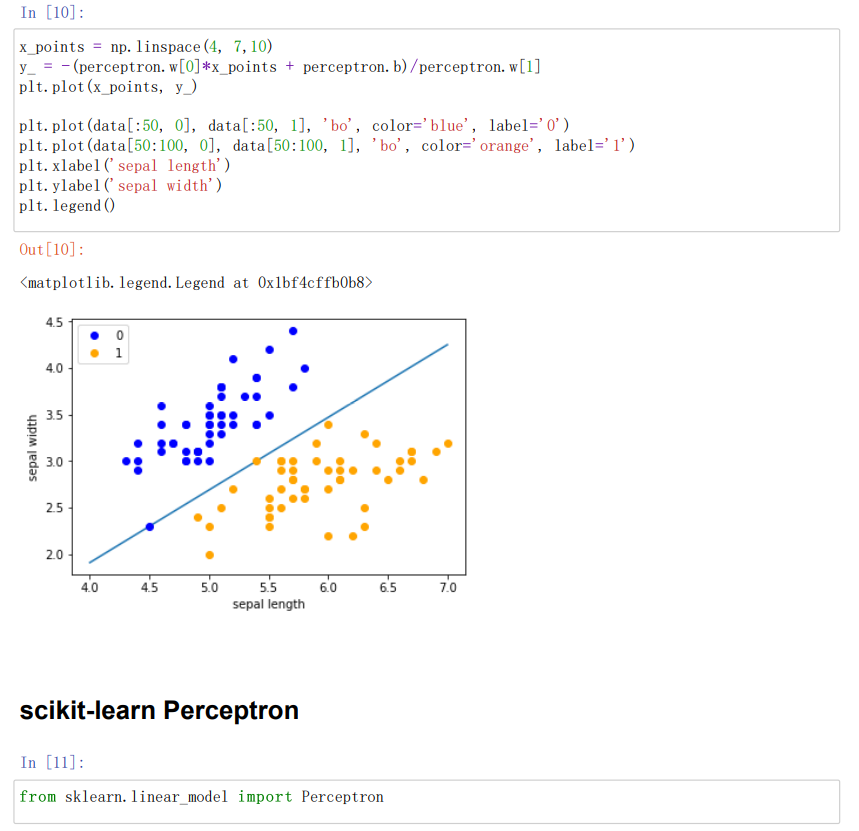
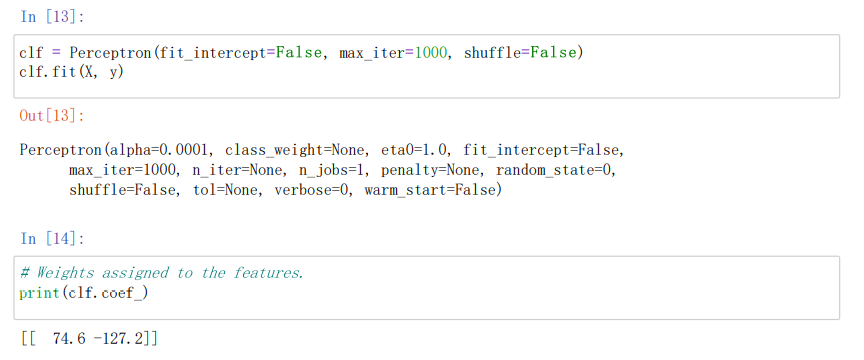

五、实验小结
感知器Perceptron在机器学习当中是相当重要的基础,理解好感知器对后面的SVM和神经网络都有很大的帮助。感知机模型作为最简单的分类学习算法是必须要掌握的。认识到自己代码能力不足,需要多多努力。




 浙公网安备 33010602011771号
浙公网安备 33010602011771号